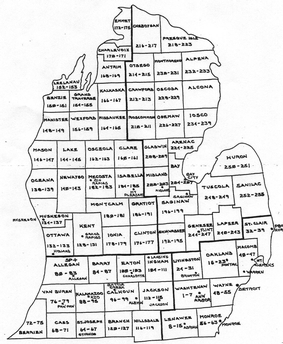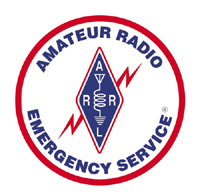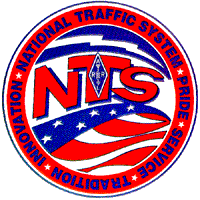First, a little about the Wordwide AMPRnet Network:
AX.25 Packet Radio began in 1983 with the TAPR Beta Test comprising only 172 "Beta boards". Michigan was one of the Beta test sites with only 6 Beta boards allocated to them. The test was coordinated by Jay Nugent WB8TKL. A few years later, Phil Karn KA9Q produced NET which implements a TCP/IP stack that used AX.25 as its "link layer" protocol. This allowed hosts to communicate easily across AX.25 links, and real networks began to spring up. NET later developed into NOS and used Microsoft DOS to get it booted into memory and running, where the NOS program then took over as the machines Operating System. NOS supports many of the TCP/IP Suite of Protocols (Telnet, FTP, Finger, SMTP, etc.) and made "networking" easy with the use of "route tables". By the 90's NOS evolved into JNOS written by Johan Reinalda WG7J and added many integrated features.
The AMPRnet (AMateur Packet Radio network) began in the late 1980's with the coordinated effort of many Ham Radio operators from all around the world. They added a feature to NOS that allowed them to tunnel 44-net packets (44.0.0.0/8) over the top of the Public Internet in order to form a kind of Virtual Private Network that only Hams could use. This prevented just any Joe Blow on the Internet from being able to key up our transmitters unless they were licensed Hams. These tunnels used the IPIP Encapsulation (Protocol 4) to make connections on a packet-by-packet basis and did not require making sustained connections. This formed a fully-meshed network where eavery node knew a direct route to every other node, eliminating any single point of failure. This made it very robust and dependable. IPIP Encap is a rather elegant solution that required very little computing resources - which were in short supply when running in a DOS environment. It is still in use worldwide even though now, most nodes are running on Linux.
The AMPRnet is coordinated by a team of very dedicated Hams. Dr. Hank Magnuski, KA6M, had the foresight to see that Internet-style networking would be the future and wanted the emerging Amateur Radio packet network to be able to participate. We were allocated a Class-A network in the 1980's when there was little demand for network space and large swaths of address space were easily obtained.
Brian Kantor WB6CYT at the University of California, San Diego (UCSD) now manages that address space and has published a paper about its use (see: A Brief Look at Internet Networking over Amateur Radio (pdf) 2011). And James Fuller N7VR, who for decades had coordinated assignment of 44/8 address space to individual users and subnets to Hamgate gateways. This was later replaced by a more automated tool called portal.ampr.org. There are thousands of un-named Hams who have worked to create a world-wide network connecting Hams across all corners of the globe, and sometimes even into space!
For more information about the AMPRnet, see the AMPRnet Wiki
About the Michigan AMPRnet Network:
The Michigan AMPRnet over the decades has gone through many growth spurts and recessions as interest in the network waxes and wanes. Just a few short years ago we had roughly 22 Hamgates operational within the State of Michigan, enabling an RF footprint the covered roughly 70% of the Lower Penninsula. This gave us connectivity to many Key Stations operating at Emergency Operations Centers (EOC) and Red Cross facilities and Hospitals. The numbers have diminished in the last couple years, but is once again experiencing a rebirth of interest and is again growing! This is especially true since DHS/FEMA/ICS are now requiring ARES/RACES/ARPSC/MARS/NTS to carry ICS form data during emergencies. The need for a digital network that can carry such traffic and be deployed quickly and easily (and inexpensively) is at the forefront. And JNOS and Hamgates can meet that challange!
 As it is with the public Internet and its over 688,000 networks (and growing), so it is with the AMPRnet, it is made up of a collection of many individual networks. The AMPRnet is worldwide and occupies the 44.0.0.0/8 address space (16.7 Million addresses). Michigan has been allocated the 44.102.0.0/16 space, with an entity also occupying 44.103.0.0/19. We then subdivided the 44.102/16 space into multiple /24 subnets based upon the Amateur population within each County. Smaller counties getting two /24 blocks and larger, more populated counties, getting as many as eight /24 blocks.
As it is with the public Internet and its over 688,000 networks (and growing), so it is with the AMPRnet, it is made up of a collection of many individual networks. The AMPRnet is worldwide and occupies the 44.0.0.0/8 address space (16.7 Million addresses). Michigan has been allocated the 44.102.0.0/16 space, with an entity also occupying 44.103.0.0/19. We then subdivided the 44.102/16 space into multiple /24 subnets based upon the Amateur population within each County. Smaller counties getting two /24 blocks and larger, more populated counties, getting as many as eight /24 blocks.
The 44.102.0.0/16 address space for the State of Michigan amounts to over 65,000 individual addresses. A rather large number of IP addresses available to each and every licenced Amateur Radio Operator in the State! Each of the /24 subnets that are assigned to the Counties, contains 256 individual IPv4 addresses. As most counties have TWO such subnets, there are at least 512 individual addresses per county, while the most densly populated counties with EIGHT such /24 subnets, amount to as much as 2048 individual addresses. Each Ham *could* have an address for their home, their cottage, their boat, their car, and their portable station! We have NEVER run out of addresses within any county.
We like to keep each /24 subnet unique - as in, not subnetting on larger that /24 boundries. That way individual stations can have an IP address within EACH subnet allowing them to choose which Hamgate they wish to route through. If there happens to be multiple Hamgates in one county (this had been the case in the Hey Days of Packet when the AMPRnet was at its peak) a home JNOS station can have an address within the subnets served by each Hamgate, thereby giving them the greatest flexiblity to route around any outages and/or use the Hamgate they most prefer.
Interoperability:
The Internet is comprised of an assortment of routers, mostly Cisco (running Cisco IOS) and Juniper (running JUNOS). The AMPRnet primarily uses a free software package called JNOS written by Johan Reinalda WG7J and is based on the prior work by Phil Karn KA9Q of NET/NOS. JNOS runs on Microsoft DOS, most Linux distributions, and can be compiled to run on many different CPU archetectures (i386, ARM, etc.) so it also runs on the Raspberry-Pi.
JNOS is its own Operating System when run atop other OS's such as Linux (on DOS it only uses DOS to get itself loaded and running). It needs to be its own OS mainly because, though it uses all the same TCP/IP protocols, it MUST use much LONGER timers and timeout algoryths because of the slower media links it is designed to work with. The Internet wasn't designed to work in a 300 or 1200 baud half-duplex, multi-user, single collision domain, environment, while JNOS *is* designed to handle such slower and noise-ridden environments. So JNOS has its own TCP/IP "stack" and timers seperate from those in the Linux kernel.
Each county typically has one "Hamgate" which acts as its "default gateway" router, not unlike
how all the Local Area Network (LAN) traffic in your home uses one gateway router to gain access
to the Public Internet, this Hamgate is the gateway to the rest of the worldwide AMPRnet for that
county. So by this arrangement, a home station running JNOS will point his Default Route
(or 44/8) toward the local Hamgate, and the Hamgate will make routing decisions as to where this
users need to be routed in order to reach the desired destination. Likewise, the destination
will use its local Hamgate to determine what route to follow to get back to the originating station.
As the Internet is made up of an assortment of different networking hardware and software, so
can the Michigan AMPRnet. JNOS is the "Swiss Army Knife" of Packet, so we prefer it to be used
as the Hamgate/Core Router positions. But other TCP/IP capable packages such as the X1J version of
NetROM can perform
this function as well. Home stations typically only have one RF interface so they rarely need
to make such routing decisions, so they may be a simple node running JNOS on a Raspberry-Pi or
BPQ on Windows, or even be a device on a high-speed WiFi MESH network such as AREDN, etc.
Many High-Speed microwave networks are available for deployment to create a "Metropolitan
Area Network, or MAN. Meshing protocols allow inexpensive WISP nodes to be put up on 2.4 GHz,
3.4 GHz, and 5.8 GHz that will automatically find one another and build routing tables between
themselves. Early work in this area was done by "High Speed Multi-Media" HSMM-Mesh. This later
branched off into what was known as "BraodBand-HamNet" BBHN. That product later evolved into
what it is known as today, AREDN "Amateur Radio Emergency Data Network". But be aware that
AREDN *does not* use DNS nor does it allow for routing to a specific IP address, but is instead
designed around the principal of routing "Services" and may not be terribly compatable with
our TCP/IP routed network.
Microwave Networks:
Though HSMM, BBHN, and AREDN are all based on microwave hardware, a truely TCP/IP routed
microwave network is more easily built on the MicroTik product line. The MI6 microwave network
constructed by the CMEN group here in Michigan is utilizing this hardware. But with any
network operating at such high LINE-OF-SIGHT bands, these units MUST be placed atop buildings
where they can SEE one another! They do not communicate through trees or over hills or pass
through or around other obsticles. Beamwidths are narrow (on the order of 6 degrees) and
aiming is critical, so the structure they are on cannot jiggle in the wind. Routers may still
be needed as not all MicroTik units have built-in routers. And then there is the cost of
securing rooftop priveledges. This can be a show stopper unless you are a WISP and have
already secured rooftop sites and are paying the rent.
Homogenous Networks made up of many:
Off of each of these "Hamgates", there may be many different types of networks being deployed behind them. A homogenous network might consist of a mixture of both old and new technologies using the AX.25, NetROM/X1J4/K-net, and TCP/IP protocols. Some networks might be the X1J version of NetROM (that support the use of TCP/IP over them) or Knet and BPQ (which does NOT support TCP/IP, but uses a completely different routing methodology). Some branch networks might be TCP/IP-native using HSMM-Mesh (WiFi) metropolitan area networks (MAN), or D-Star, or WinLink, and some even ride over the top of WISP (Wireless Internet Service Provider) networks. By using whatever technologies are available to us assures that each district within the State can deploy the technology that works best for their particular needs. What works best in one part of the State may not be the right solution for another. Our ultimate goal for the network is to move bits from Point-A to Point-B by whatever means we can, including the use of the Internet where Terrestrial RF paths may not yet be available.



